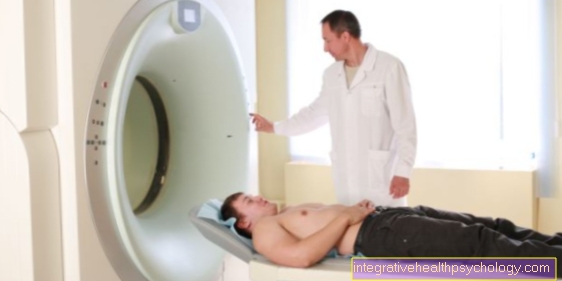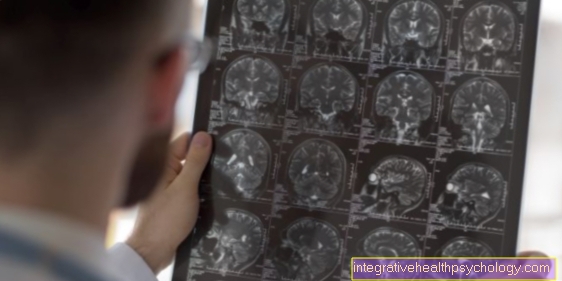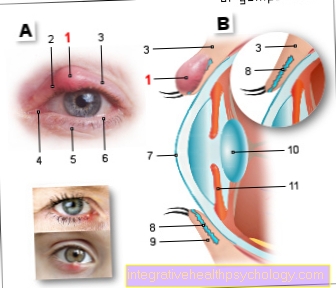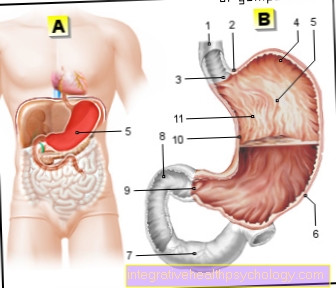CT-guided pain therapy
definition
CT-controlled pain therapy is a special method for combating pain that can be used in particular in cases of wear and tear in the spine that lead to back pain.
Therapy can also be considered for pain due to cancer that cannot be treated in any other way. Under imaging control by a computed tomography (CT), a needle is pushed through the skin into the area causing the pain. There, targeted pain reliever medication can be dispensed.

Indications for CT-guided pain therapy
CT-guided pain therapy can be considered to treat diseases or symptoms of the spine.
This primarily includes pain caused by a herniated disc. This form of pain therapy can also be indicated in the event of a narrowing of the bony spinal canal (spinal canal stenosis). Both diseases can cause nerve irritation to cause pain and occasionally tingling and numbness.
Another indication for CT-controlled pain therapy in the spine arises in cases of wear diseases of the intervertebral joints (facet joint arthrosis or spondylarthrosis).
However, the procedure should not be the first of choice but should only be considered if other measures such as exercise therapy (physiotherapy, back training) and pain medication cannot provide relief.
If an operation has already been performed on the spine that is causing the pain, CT-guided pain therapy can also be a treatment option.
Another indication arises in the case of incurable tumor diseases such as gastric or pancreatic cancer.
If the pain cannot be treated in any other way, a CT-guided injection of high-percentage alcohol can be performed on a nerve plexus in the upper abdomen, in order to obliterate it and thereby relieve the pain.
Appointment with a back specialist?

I would be happy to advise you!
Who am I?
My name is dr. Nicolas Gumpert. I am a specialist in orthopedics and the founder of .
Various television programs and print media report regularly about my work. On HR television you can see me every 6 weeks live on "Hallo Hessen".
But now enough is indicated ;-)
The spine is difficult to treat. On the one hand it is exposed to high mechanical loads, on the other hand it has great mobility.
The treatment of the spine (e.g. herniated disc, facet syndrome, foramen stenosis, etc.) therefore requires a lot of experience.
I focus on a wide variety of diseases of the spine.
The aim of any treatment is treatment without surgery.
Which therapy achieves the best results in the long term can only be determined after looking at all of the information (Examination, X-ray, ultrasound, MRI, etc.) be assessed.
You can find me in:
- Lumedis - your orthopedic surgeon
Kaiserstrasse 14
60311 Frankfurt am Main
Directly to the online appointment arrangement
Unfortunately, it is currently only possible to make an appointment with private health insurers. I hope for your understanding!
Further information about myself can be found at Dr. Nicolas Gumpert
Preparations for a CT-guided pain therapy
Before CT-guided pain therapy can even be considered, a thorough examination by an orthopedic surgeon, neurologist or neurosurgeon should be carried out.
Only if other attempts at treatment such as exercise therapy (e.g. back training) or pain medication have not led to satisfactory relief and the doctor considers CT-guided pain therapy to be appropriate, a referral should be made to a corresponding radiological center or clinic.
In order to be able to carry out the treatment, an imaging examination using computed tomography (CT) or magnetic resonance imaging (MRI) must have already been carried out. This imaging must not be more than a year ago.
Another important part of the preparation is a detailed medical explanation with the opportunity to discuss open questions from the patient. In addition, a current check of the blood coagulation and, if necessary, kidney values must have taken place.
Course of a CT-guided pain therapy
If a referral for a CT-controlled pain therapy has been made to a suitably equipped practice or clinic, an informative discussion with the doctor will be held there before the first treatment.
For the therapy, the patient then lies down on the computer tomography table. Treatment of the lumbar spine is performed in the prone position, while therapy in the thoracic or cervical spine requires a supine position.
The treatment itself is carried out by placing a thin needle over the skin to the point of pain that is causing the pain. The computer tomography carried out at the same time is used for imaging and visual control of the needle inside the body.
The puncture into the skin can be compared to taking a blood sample and is therefore not very painful. As soon as the needle is correctly placed, a pain reliever and usually a cortisone preparation are administered through it.
These are so-called depot drugs, which means that the effect is released slowly and continuously over a longer period of time.
The dose is chosen individually and made dependent, among other things, on the intensity of the pain. The next treatment takes place after about two to six weeks.
How many treatments are carried out also depends on the individual. Usually between two and eight dates are chosen.
After the treatment, it is advisable to be brought home by a companion. However, the patient should remain in the practice for 15 to 30 minutes for monitoring beforehand.
If you want to drive your own car, you have to wait at least 30 to 60 minutes after placing the syringe. You shouldn't drive a car if you have sensory disturbances or abnormal sensations in your leg. In addition, heavy physical activity should be avoided on the day of treatment. However, there are no other everyday restrictions.
Risks of CT-guided pain therapy
The risks of complications with CT-guided pain therapy are rather low.
Very rarely, for example, bleeding or infection from the puncture may occur. The occurrence of an allergic reaction is also rare. In extremely rare cases, permanent damage such as paralysis occurs as a result of an injury to nerves.
Depending on the location of the operation, there is a risk of injuring neighboring organs. In the thoracic spine area, an accidental puncture of the lung membrane can cause the lungs to collapse (pneumothorax), which would require hospital treatment.
Injuries to blood vessels, intestinal loops or the kidneys, which in extreme cases can lead to complications such as blood poisoning, peritonitis or a stroke, are possible but also very seldom with treatment in the lumbar region.
The radiation exposure caused by computed tomography (CT) is only very low with this treatment and the benefits usually outweigh the risks.
Side effects of CT-guided pain therapy
If there are side effects due to CT-guided pain therapy, they are usually harmless and temporary.
The frequently administered cortisone can cause headaches, an increase in blood pressure and blood sugar and / or reddening of the face. Further side effects of cortisone such as weight gain and fat deposition are only very rarely to be expected, even with frequent treatment cycles.
Another possible but rare side effect is temporary paralysis in one leg, which can last for several minutes to hours.
You might also be interested in: Cortisone injections - areas of application and side effects
CT-guided pain therapy at different locations
CT-guided pain therapy in the cervical spine
CT-guided pain therapy for the cervical spine is rarely performed.
The patient takes a supine position. The most common indication for therapy on the cervical spine is pain due to a herniated disc.
CT-guided pain therapy in the lumbar spine
In the lumbar spine (lumbar spine), CT-controlled pain therapy is usually performed due to pain caused by a herniated disc or wear and tear on the intervertebral joints (facet arthrosis). Due to the high level of stress, wear and tear and secondary diseases are particularly common in the lumbar spine. The treatment is carried out in the prone position.
Duration of a CT-guided pain treatment
The treatment time for a CT-guided pain therapy is usually around five to ten minutes. In addition, there may be waiting times and the time for the medical consultation before the first implementation of the therapy.
It should also be planned that the patient should remain in the practice for 15 to 30 minutes for monitoring after completion of the therapy. If you want to drive your own car, you should wait at least 30 to 60 minutes.
Cost of CT-guided pain therapy
The cost of a single injection for CT-guided pain therapy is in the range of around € 100 to € 250. The cost of computed tomography can also be added.
Since the costs for CT-controlled pain therapy are only covered by the statutory health insurance under certain circumstances, many practices offer treatment as a so-called IGEL service (individual health service). The costs incurred must be borne entirely by the patient himself.
Are the costs of the CT-controlled pain therapy partially covered by the statutory health insurance?
The costs of a CT-controlled pain therapy are only covered by the statutory health insurance under certain circumstances.
On the one hand, a doctor with the additional designation “special pain therapy” must issue the referral.
In the case of a referral by doctors without this designation, the costs will not be covered, even if they are specialists in orthopedics or neurology.
In addition, costs are only reimbursed by the statutory health insurance if the CT-controlled pain therapy is used in conjunction with facet therapy, i.e. in the case of pain due to a disease of the intervertebral joints. Pain due to a herniated disc is therefore not accepted for reimbursement by the statutory health insurance.
The treatment can then only be carried out if the patient pays the costs. In this case, no referral from a pain therapist is necessary.
You might also be interested in: Therapy of facet syndrome





























